A brief glimpse into Walther's P38 / P1 Pistol: From the microwave to Facebook
Posted by Dan the Man :D on Nov 14th 2024

Image (1): P1 pistol laid out with surplus Bundeswehr equipment. (Credit to Mark Fingar)
From the Great War to greater pistols:
The First World War brought about a host of technological discoveries and innovations from penicillin to Mustard gas, countless vital leaps forward were made in industries the world over. The German state was soon to find out however, that the simple creation of an excellent product does not dictate its effectiveness. This is due to one crucial factor: supply. After all, even the best of weapons would prove ineffective if deployed piecemeal and in insufficient numbers. The Great War taxed the countries and those within it to a degree not yet seen in warfare from resources to blood; the numbers were as astronomical as they were soul-crushing. By the end of the war the German arms board found itself having to contend with a years-long Entente blockade on imports, leading to an increased need to streamline production of products whenever possible.
An excellent example of this method of economizing various products is found in the primary sidearm of the German military at the time, the P08 Luger. Utilizing a toggle-lock system, the P08 fired the 9x19mm Parabellum round and carried 8 rounds in its magazine. Troops enjoyed it; however, it was difficult to produce and incredibly expensive compared to other pistols of the time. For context, a report in 1927 by the War department stated that the simplest FN-Browning pistol at the time required 55 manufacturing procedures, compared to the 1,180 required for the P08 (Walter, 22).This blog will dive into the result of this need for an easier to produce pistol, that was just as accurate as the P08: The Walther P38 pistol.

Image (2): Waffen-SS soldier holding a P08 Luger pistol.
The Interwar period: Fine-tuning & Production begins:
The aforementioned report by the German War Department began the arduous process of designing this new model pistol. By the early 1930s, the most promising design submitted was Walther's Militär-Pistole. This design was an amusing example of the adage of “If it ain’t broke, don’t fix it!”. The Militär-Pistole was an enlarged longer Polizei Pistole (more well known simply as the Walther PP) chambered in 9mm. Interestingly, this pistol was straight blowback like the 7.65 version which caused issues with the war department who preferred a locking-breech for the increased safety it would provide. It is fascinating to put these pistols next to one another to see the evolution from a THICC Polizei Pistole to the P38; I’ve displayed them in order below from start to finish for you to see as well.

Image (3): Militär-Pistole sold at Rock Island Auction..
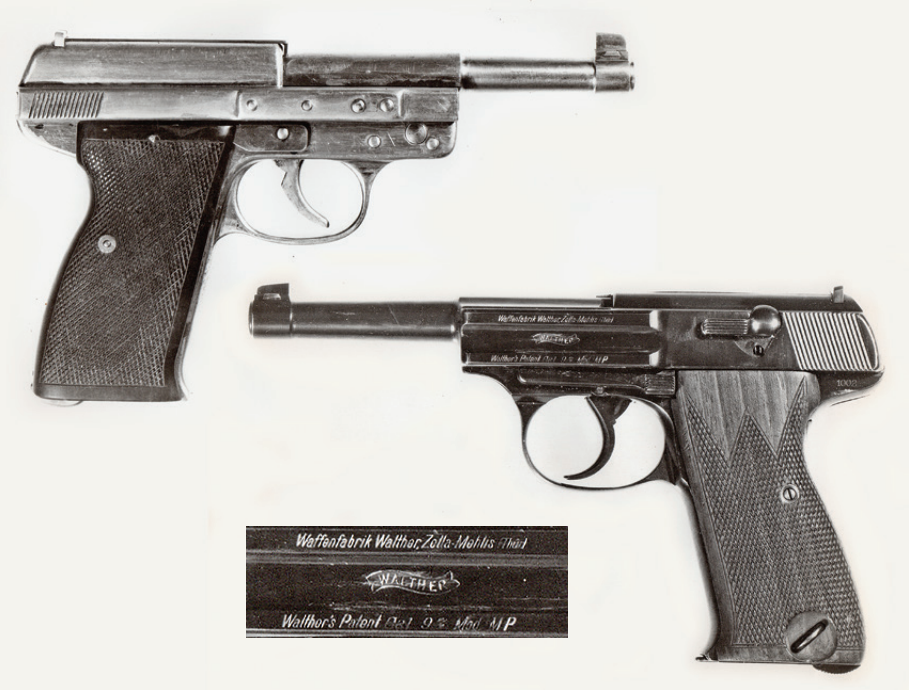
Image (4): Sheet-metal Walther MP III (Left) & MP IV (Right).
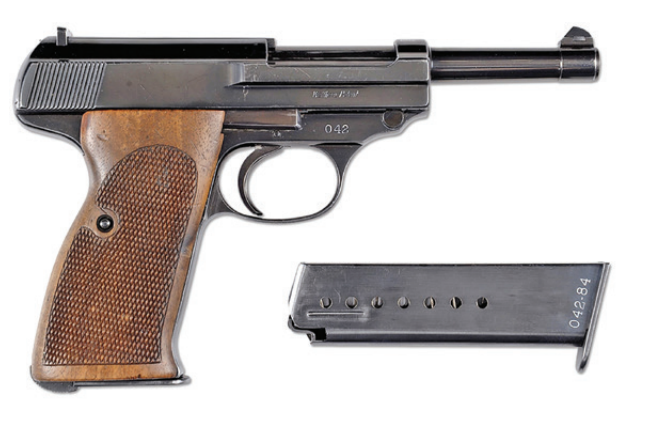
Image (5): Armee-Pistole No. 042.

Image (6): Heeres-Pistole P-38.
In true German fashion the design was tinkered with and worked on throughout the war, however the Heeres Pistole P38 began commercial production in April 1938 (Walter, 27).The final product was a locked-breech SA/DA pistol chambered in 9x19mm Parabellum with an external hammer and decocker much like the Polizei Pistole. The magazine holds eight rounds with one in the chamber, giving it a good middle ground between the 7.65 cartridge of the Polizei-Pistole and the later encountered 45 ACP of the M1911 pistol. These magazines also have a "heel" release which some shooters dislike, but I for one accept our European magazine release overlords and have warmed up to it after using it a few times. The decocker on the P38 is another personal favorite of mine due to my having concealed-carried a PPK for quite a long time. It allows the user to safely carry the pistol with a round in the chamber. All you have to do is rack the slide and chamber a round, then flip the decocker down to safe lowering the hammer. To fire you just have to flip the safety off and pull the trigger! The first round is double-action, with every subsequent round being single-action.
Video (1): Author firing a friends P1 pistol. (Credit to Phillip Chung for the video & letting me try out his Walther).
Now that we've gone over the development and a brief description of the pistol itself let's see how it faired in the largest war the world has yet seen!
The P38 at war: Breech-lock überalles:
By the outbreak of war in September 1939, the German armed forces still technically only had the P08 Luger as their official sidearm. The P38 was not officially adopted until 1940, with more P08 Lugers being assembled after 1940 from parts in small batches for the rest of the war. An inter-service supply report in 1940 before it was adopted, showed the German armed forces had around half a million pistols, predominately Lugers, with a few thousand smaller blowback pistols. Many officers were expected to have a pistol for defense and thus, they had a lot of leeway in the model and caliber of what they carried. This along with the forced impressment of all civilian pistols led to many officers carrying essentially whatever they could get their hands on at times; especially as the war drew to its conclusion.
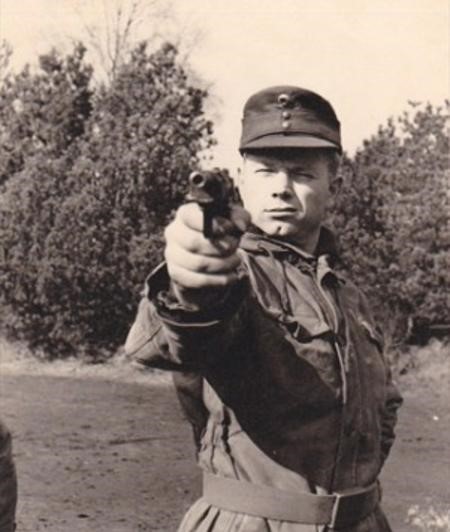
Image (7): Wehrmacht soldier sighting in his Walther P38 pistol.
An interesting note is that although the P38 was officially the sidearm for every arm of the German military it saw very limited use by flight crews. This simply came down to the tight spaces they had to wedge themselves into, where they much preferred a small PP or PPK that was easier to store, taking up much less space than its chunky brother (Walter, 38).
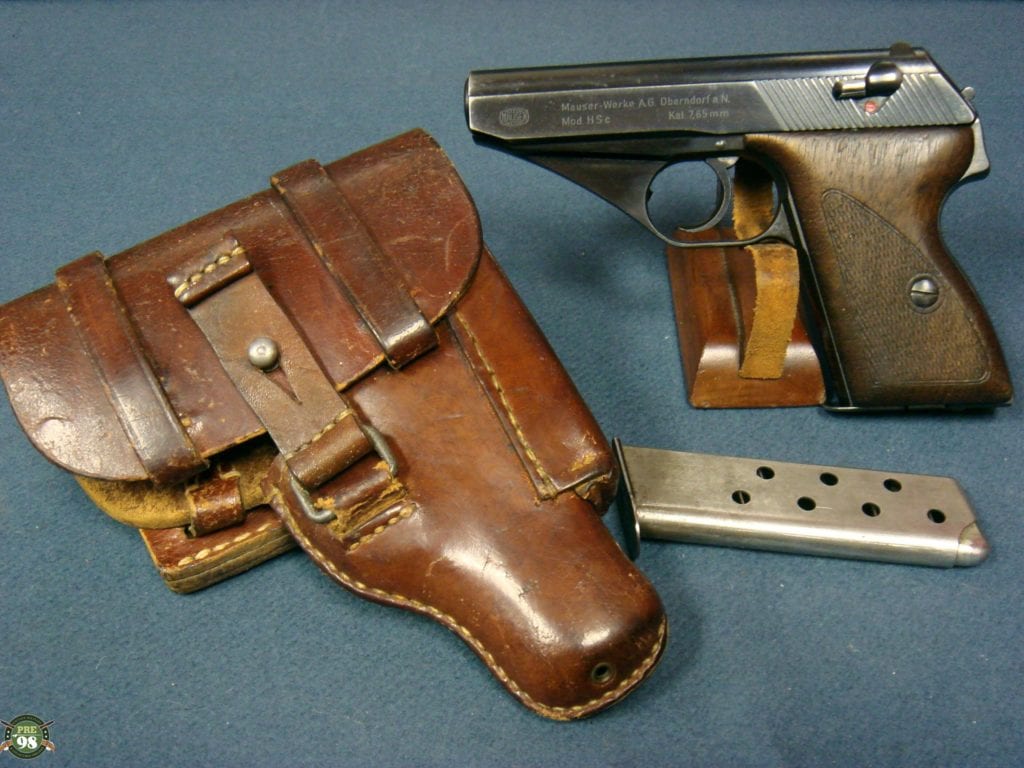
Image (8): Mauser HSC pistol aircrews may have preferred. (Credit to Pre98 Antiques)
Other than the Luftwaffe, troops in every theater of the war were armed with P38's. Soldiers generally found it helpful that the pistol could be easily switched off safe and immediately fired. I assume this feature saved a few soldiers who may have otherwise been in some very difficult situations! The P38 was also found to be excellent for follow-up shots due to every shot after the first engaging the pistol's single action. Regardless of which side the soldiers were on, soldiers tended to look fondly on the chunky Walther as a dependable and accurate sidearm. The Germans weren't the only ones who used these pistols during the war. Partisans across Europe used them to fight back against Nazi occupation from France to Russia, where there were Germans there tended to be at least a few P38 toting partisans.

Image (9): Two members of the Polish Warsaw Uprising armed with TT-33 & P38 pistols.
In fact, one of the more glowing endorsements comes from the deadliest female Soviet sniper of all time, Lyudmila Pavlichenko. She stated that the P38 was compact, simple to use, and easily maintained. She made sure to note the safety catch which was absent on her Soviet counterpart Tokarev pistol. British forces also interestingly tended to pick up P38s, due to the above-mentioned qualities, along with the fact that it offered faster reloads compared to their Webley revolvers.

Image (10): Soviet sniper Lyudmila Pavlichenko, credited with killing 309 Nazi combatants.
By the second half of the war, there were tens of thousands of Allied troops fighting the Germans in North Africa, Italy, & Western Europe. Here, many American soldiers understandably took trophies ranging from uniforms to firearms. It was said of Allied trophies that, "Lugers were the best souvenirs, and P38s were the best shooters". There may be some truth in this, as I know I would certainly take a Luger over a P38 in a contest of "coolness", but I'd also prefer the P38 with its decocker to a P08 if my life depended on it.
I want to include one final (kind of awful) note on these wartime P38s. Although the Germans made over a million of them during the war, it was never enough to fully equip their forces. This led to the P08 still seeing service, but it also led to designers attempting to strip these pistols down to their barebones to increase production. Have you ever wondered what happens when you take an already economically sound pistol and strip it down to the exact number of parts it takes to function? If you have, then behold, the Walther Volkspistole!

Image (11): Walther's attempt at a cheaper P38, the Volkspistole.
This pistol looks pretty awful, but when you're running out of everything and surrounded on all sides, I suppose you play the card you've been dealt! These were made by Walther as a more cost efficient version of the P38s and would have gone to the Volksturmm, the badly armed militia of crippled soldiers, children, and anyone else who hadn't already been drafted.
The Cold War Era: Brrrrt chilly:
The end of the Second World War marked a shocking end to P38 production that I bet no one saw coming. Before the dust had settled, the uneasy alliance between the Western Allies and the Soviet Union fell apart almost instantly. As these tensions crescendoed into the ensuing "Cold War" the West German state established by the Americans decided re-arming, was probably a solid idea.
The post-war Bundeswehr had the same thought process as the designers of the first P38 model, "if it ain't, broke don't fix it!". They took this kind of advice to heart and continued using old stocks of P38s, however they also created an even MORE economical model, the P1 pistol.

Image (12): P1 pistol. Note the reinforcement bolt above the trigger. (Credit to Ralf Dillenburger)
The P1 was cheaper for the West Germans to mass produce due to the aluminum frame they used instead of the steel one of their wartime predecessors. The parts all interchange, so you often find P1 pistols with P38 parts or vice versa. These new pistols would be used alongside the P38, eventually overtaking it as the primary sidearm of the West German Bundeswehr. In 1975 they introduced a reinforced aluminum frame and thicker slide to help with durability and longevity. You know your pistol is the reinforced model if it has the reinforcing bolt above the trigger guard.
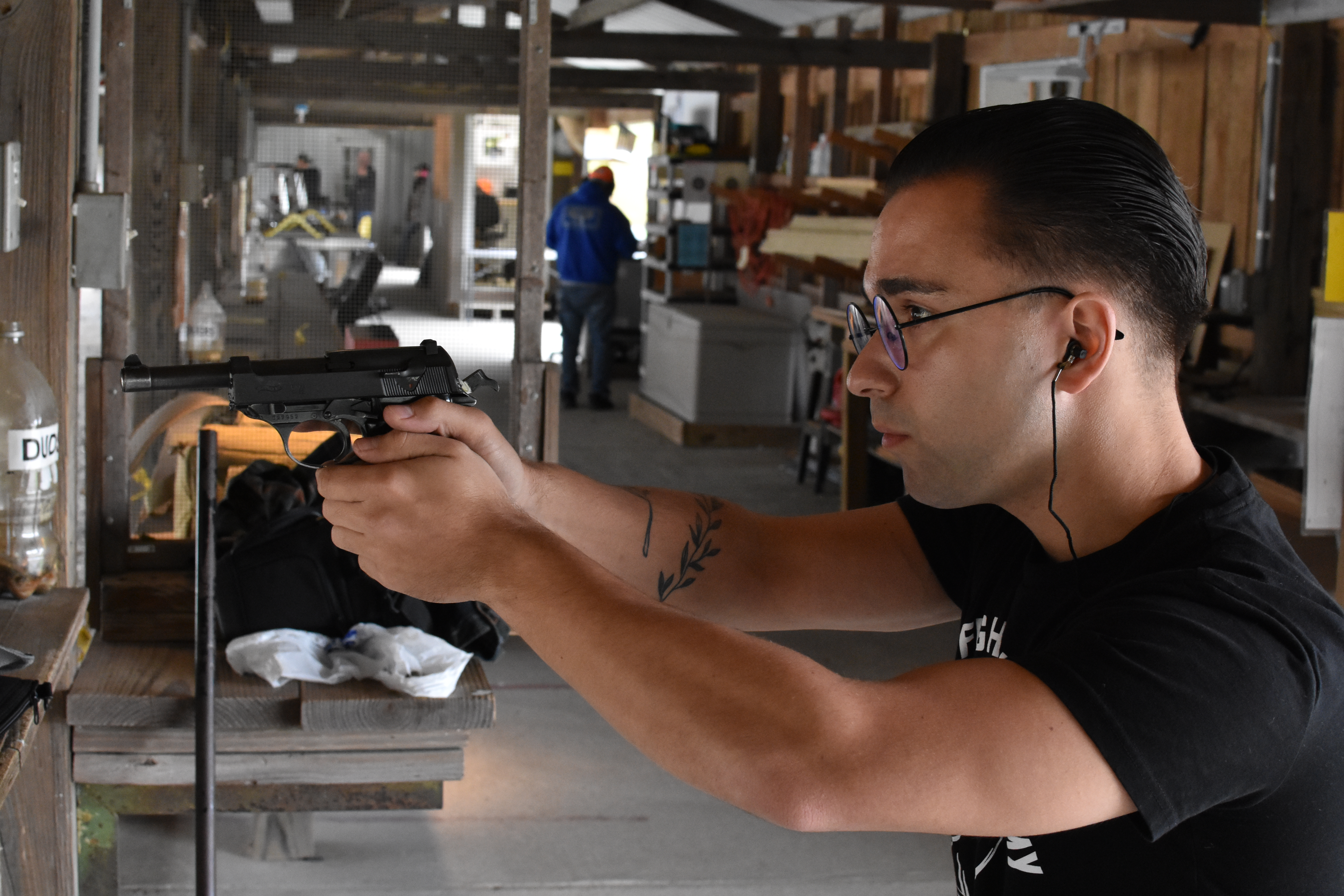
Image (12): Yours truly firing his first P1 :). (Credit to Phillip Chung)
Other than the frame and some other minor differences, the P1 served the same role as the P38 up until 2004. That means the P38 in its wartime & cold war forms was old enough to see the invention of the microwave as well as Facebook! Hence, my lovely title that finally makes sense at the very end of this blog (amazing job Dan). These P1s generally run for around $500-600 making them the much more affordable of the two "P38" pistols. If you do purchase one of these, make sure to replace the recoil springs due to them generally being fairly worn. A close friend of mine clued me in on the most durable version of the P38: A steel P38 frame with the updated chunky P1 slide and new recoil springs. It sounds like it would shoot great with that setup! These Walthers are relatively plentiful, but as I'm sure you know dear reader, the surplus always runs dry. In closing, I won't tell you what to do, but if I saw a great condition Walther for just a couple hundred bucks I sure know what I'd do!
Sources:
Pavlichenko, L. M., Pegler, M., Foreman, D., & Begunova, A. (2021). Lady Death the memoirs of Stalin’s sniper. Read How You Want.
Walter, J., Hook, A., & Gilliland, A. (2022). Walther pistols: Pp, PPK and P 38. Bloomsbury Publishing Plc.

